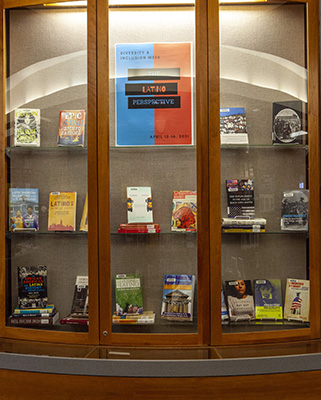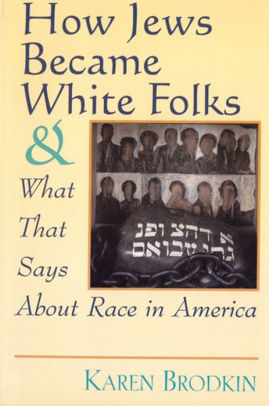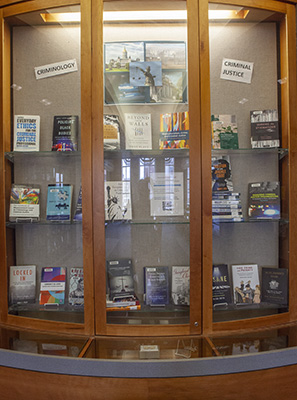- Apply
- Visit
- Request Info
- Give
Eastern hosts Diversity and Inclusion Week
Written by Dwight Bachman
Published on April 21, 2021
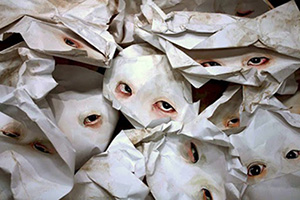
Timothy Hyunsoo Lee, "Hello Eyes," 2013
From April 12-16, Eastern Connecticut State University’s Student Affairs Diversity and Inclusion Committee sponsored a week of in-person and virtual events to raise public awareness and encourage students to embrace concepts of diversity and inclusion.
Latino Book Exhibit
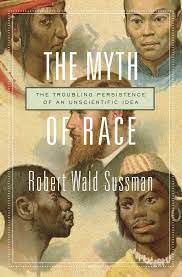 Throughout the week, OLAS (Organization of Latin American Students), in collaboration with the J. Eugene Smith Library, sponsored a book exhibition on Latino history and culture on the second floor of the library; the exhibit is available online as well at https://easternct.libguides.com/exhibits/latinosanddiversity
Throughout the week, OLAS (Organization of Latin American Students), in collaboration with the J. Eugene Smith Library, sponsored a book exhibition on Latino history and culture on the second floor of the library; the exhibit is available online as well at https://easternct.libguides.com/exhibits/latinosanddiversity
Librarian Kellie O'Donnell-Bobadilla, who organized the exhibition, said she was happy the library was involved in Diversity Week. She had been looking for ways that the library could contribute to diversity and inclusivity awareness at a local level. She felt a book exhibition was an excellent way to help advance the conversation.
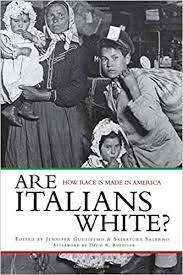 The library has many resources on anti-racism, inclusion, diversity, equity and justice, including a web guide by Angela Walker: https://easternct.libguides.com/diversity. While the library staff serves and supports all groups, O’Donnell chose to focus on the experiences of Latinos.
The library has many resources on anti-racism, inclusion, diversity, equity and justice, including a web guide by Angela Walker: https://easternct.libguides.com/diversity. While the library staff serves and supports all groups, O’Donnell chose to focus on the experiences of Latinos.
“Latino students make up 11.5 percent of the student body on campus, so I think it’s important to learn about and understand the perspectives of these students, as well as our Latino faculty and staff. In fact, I am doing a study on how to improve Eastern’s library services to Latino students to ensure their success, growth and future employment prospects. We also want to do our part in attracting and retaining more Latino students in the future. My hope is that through the exploration of the books in the exhibition, we will learn and understand more about the inequities faced by Latinos in the United States.”
BIPOC Support Group
On April 12, the Counseling and Psychological Services (CAPS) sponsored a virtual session to help students learn more about the campus-wide BIPOC (Black, Indigenous, People of Color) support group.
Diversity Training
A virtual Student Diversity Training session on April 13 aimed to educate students on issues of diversity and inclusion before entering the workforce. The training session explored unconscious bias, cultural humility, identifying and resisting biases in the workplace, and how to manage one’s own biases.
Digital Diversity
On April 15, the Office of AccessAbility Services (OAS) sponsored a virtual session on “Digital Diversity, Equity and Inclusion.” The goal was for students to develop an understanding of how diversity, equity and inclusion also includes access to digital content.
Who Invented White People?
On April 15, the Arthur L. Johnson Unity Wing sponsored a presentation titled “Who Invented White People?,” a program lead by Art Gallery Director Yulia Tikhonova. Tikhonova focused on the ways that race and racism shape experiences and the world across a range of time and places. Students engaged in hands-on activities of drawing and sketching, to describe whiteness, recognize privilege, biases and address racism performed through their individual and collective actions.
Tikhonova said learning about race and racism is a process. She said many believe the best way to eliminate racism is to not talk about it and not notice racial differences at all — for example, to be ‘colorblind.’ “It’s a way to avoid dealing with discussions of race because they are uncomfortable.”
Tikhonova cited colonial records showing that when the first Africans arrived in Virginia in 1619, there were no ‘white’ people; nor would there be for another 60 years. America invented whiteness, said Tikhonova, when the concept of whiteness started in the late 1600s in America.
Tikhonova said history demonstrates that the descendants of Europeans, through land ownership, voting rights and slave ownership, established their own privilege over nonwhites. “They constructed a myth of themselves as a white superior race, solidifying the white population. Whiteness is one of the biggest and most long-running scams ever perpetrated.”
The week ended with a Diversity and Inclusion Accountability Conference on April 16.


